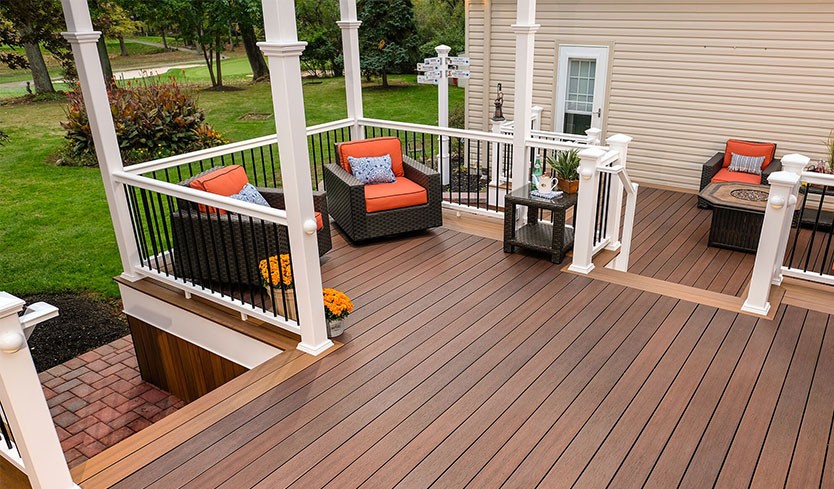When comparing composite decking and timber decking, it’s not always easy to identify which is which on initial observation. Although composition decking is made from a combination of wood fiber, plastics, and other materials that bind these components together, the look and texture of the boards are largely down to the timber element and the appearance this produces.
While timber decking boards are often made from pressure-treated timber however in their natural state, redwood or cedar wood are often a popular choice. There are advantages and disadvantages of using composite decking in comparison to timber from the amount of time it lasts, your preferences in terms of appearance, and of course the budget of the project you’re working on.
Does composite or timber decking last longer?
In terms of the longevity of your decking, timber is most certainly usually a long-lasting choice. Typically, composite decking board lasts for approximately 20-30 years, whereas timber decking boards have a lifespan anywhere from 20-45 years. If a long last decking is important to your timber decking may be a more suitable choice, however many people are convinced by composite decking because of the maintenance that the timber requires.
The timber will need to be maintained by consistently being oiled to provide an ongoing protective coat to the wood. The artificial elements of the composite decking mean that this level of maintenance is not necessary, so although overall your decking is not likely to last as long you do not need to commit to looking after it in the same way as timber decking boards.
In terms of the appearance of your decking, there is much more flexibility with composite decking. There is a very vast range of colors to choose from if there is something specific you have in mind, so there is certainly an increased degree of flexibility in the way your decking can look with composite boards.
Timber can be slightly limited with the choice of natural colors, there are various timber varnishes on the market so coloring your timber decking is a possibility. However, making this decision does come with the aforementioned issue of ongoing maintenance and oiling.
Composite Decking vs Timber Decking – Which is more expensive?
The price range of both composite and timber decking can vary hugely depending on what it is you require for your project, however, overall composite is considered a more expensive alternative to timber.
Although some types of hardwood decking are just as expensive as composite, there are much more affordable options when considering timber decking. Many people are happy to pay a higher price for composite decking knowing that it is easier to maintain and clean, and those factors are worth the extra cost initially.
For more of an idea of prices check out Hanworth Timber who sells timber & composite decking.
Composite decking boards do have some additional advantages over natural wooden decking boards, a few of them include the following:
- Composites are resistant to abnormal temperatures. Timber decking can degrade under extreme conditions over time.
- Composites can withstand environmental attacks like corrosion and other moisture-related conditions. Timber decking cannot always withstand all environmental conditions. This can be especially observed over a period of time.
- Composite decking can withstand a variety of cleaning materials and agents. This means that you can use a variety of different products to make it look clean and shiny without worrying about the effects or damaging the materials.
Other aspects to consider…
Composite decking can often produce a slippery surface, particularly when wet. This is an important factor to consider ahead of your project: it’s important to think about your safety, for example, if you are elderly or have young children that will be running around. If you live in a dryer country overall this may be less of an issue for you, however, the slipperiness can even be activated by a small water spill like a drink. It’s much less likely to experience these types of hazardous issues with timber decking.
Although many people choose composite decking due to the lack of maintenance required, there are advantages of being able to oil and varnish timber decking. If any scratches or dents appear in your composite decking boards the only real way to get rid of these is to replace the boards, which can be time-consuming and expensive.
At least with timber decking, it is quite straightforward to sand or buffs out any scratches or marks that appear over time. There is also an array of different timber products for purchase that can help conceal stains, marks, and indentations.
In summary, there are many pros and cons to both composite and timber decking boards and they can both be an excellent choice depending on your requirements, both practically and personally. If your budget is flexible, you want little to no maintenance and something that will look striking and unique, perhaps a composite decking would be the best fit for you.
With composite decking, there is much more variety in terms of the aesthetic of the final project and the material is more resilient. Timber decking has the advantage of assured durability.
Although a timber decking will require ongoing maintenance this can be viewed as an advantage because the boards are more likely to be able to be repaired rather than just replaced and can last many years longer. When deciding which of these options will suit you it’s important to consider your lifestyle and what will work best for you.
